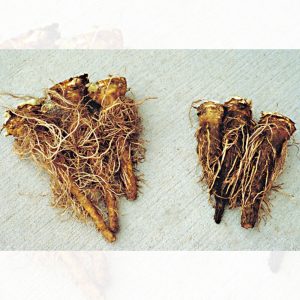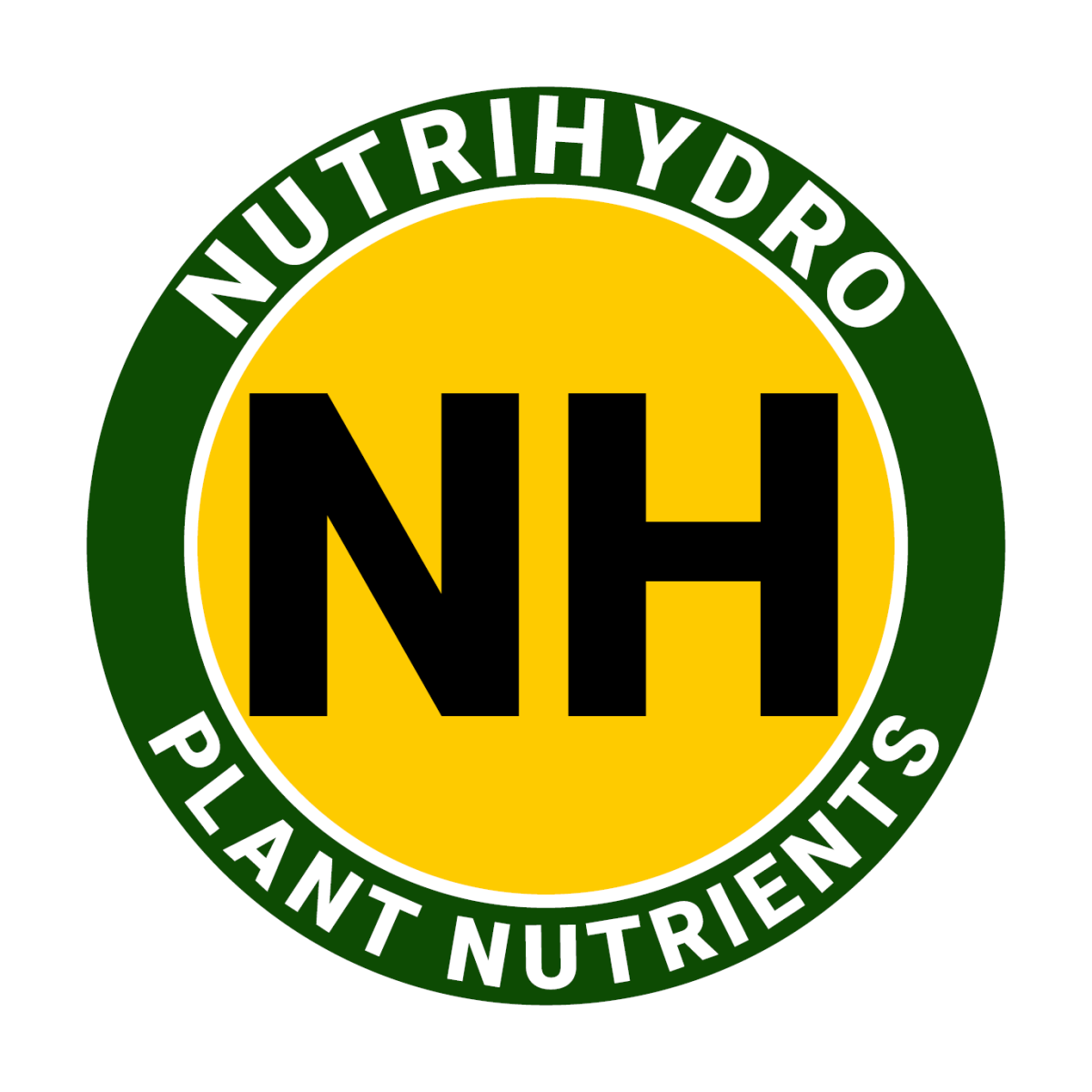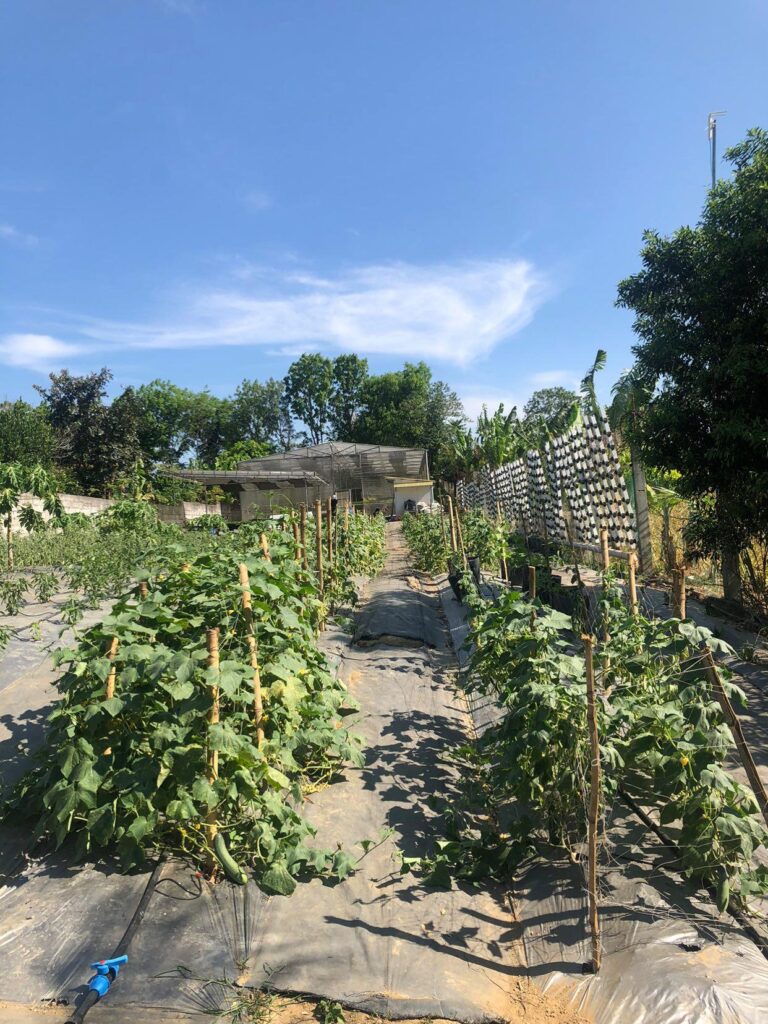Corky Root: Lettuce
I. WHAT IS CORKY ROOT
 Corky root is a soil-borne disease that severely impacts hydroponic and traditional agricultural systems alike. This malady manifests as woody, cork-like lesions that form along the roots of affected plants, stunting growth and inhibiting nutrient uptake. These symptoms can result in diminished yields, compromised quality, and if left untreated, may culminate in plant death.
Corky root is a soil-borne disease that severely impacts hydroponic and traditional agricultural systems alike. This malady manifests as woody, cork-like lesions that form along the roots of affected plants, stunting growth and inhibiting nutrient uptake. These symptoms can result in diminished yields, compromised quality, and if left untreated, may culminate in plant death.
Overview of the Disease
Although corky root tends to be more prevalent in poorly drained soils, hydroponic systems are not immune to its deleterious effects. This disease thrives in overly wet and oxygen-deprived conditions, making hydroponic setups especially susceptible when water management is less than optimal. The primary harm lies in the compromised root system, which has far-reaching impacts on the plant’s ability to absorb essential nutrients and water. This nutrient deprivation leads to stunted growth, yellowing of leaves, and reduced crop yields. Consequently, corky root is a major concern for both novice and experienced growers who seek to maintain a high standard of plant health and productivity.
What Fungus, Bacteria, Organisms Cause Corky Root?
The primary causative agent for corky root in lettuce and other susceptible plants is the bacteria Rhizomonas suberifaciens. Unlike many soil-borne pathogens, Rhizomonas suberifaciens thrives in a waterlogged environment, which is why hydroponic systems can be particularly vulnerable. The bacteria infiltrate the root system, creating a host of physiological changes that ultimately lead to the cork-like formations from which the disease derives its name.
Affected Plant Species Apart from Lettuce
While lettuce is often the poster child for corky root due to its economic importance and prevalence in hydroponic systems, other plant species are not impervious to this disease. Various members of the Brassicaceae family, such as broccoli, cauliflower, and cabbage, have also been reported to succumb to corky root. Additionally, certain herbs like cilantro and root vegetables like radishes and carrots can be affected. This wide host range makes corky root a concern that transcends specific crops, affecting a broader spectrum of plant species.
By understanding the nature of corky root, its causes, and the range of plants it affects, growers can take proactive steps to manage and mitigate this disease. Rhizomonas suberifaciens, being the main perpetrator, should be a focal point in any preventive or treatment strategy. The disease’s broad host range also underscores the need for vigilance across different crop types.
II. SYMPTOMS AND IDENTIFICATION
One of the first warning signs of corky root in hydroponic lettuce cultivation is the appearance of small, cork-like lesions on the roots. Over time, these lesions become more pronounced and numerous, leading to a distinct hardening and deformation of the root structure. Affected roots may exhibit browning, reduced branching, and diminished root hairs. Above ground, plants often display stunted growth, wilting, and discoloration of leaves, including yellowing or browning at the margins.
Visible Symptoms
In a hydroponic system, one of the most striking features is the obvious deformity of the root system. Roots take on a gnarled, irregular appearance and lose their smooth texture. The cork-like lesions can be clearly observed, and in severe cases, they coalesce to form large cankers that severely impede nutrient and water uptake. It is not uncommon to see reduced vigor in the foliage and a general decline in overall plant health.
Microscopic Features
While visible symptoms offer valuable cues, microscopic analysis provides definitive identification. When examining root samples under the microscope, bacterial colonies of Rhizomonas suberifaciens can often be observed embedded in the root tissue. These bacterial aggregates are typically rod-shaped and may be found in clusters, confirming the presence of the pathogen responsible for corky root.
Tools and Techniques for Identification
Accurate identification of corky root involves a combination of visual inspection and more advanced diagnostic tests. A simple hand lens can be useful for a preliminary analysis of the root structure. For a more conclusive diagnosis, root samples can be sent to diagnostic laboratories for culturing and microscopic evaluation. Molecular techniques such as polymerase chain reaction (PCR) can also be employed for accurate detection of Rhizomonas suberifaciens. These laboratory-based methods are especially useful in hydroponics, where early detection is critical for implementing control measures and limiting the spread of the disease.
In summary, the symptoms of corky root manifest both visibly and microscopically, necessitating a multi-pronged approach for accurate identification. Hydroponic growers, given the sensitivity of their systems to waterborne pathogens, should be particularly attentive to these diagnostic methods.
III. ETIOLOGY (CAUSE)
Pathogen(s) Responsible
The primary culprit behind corky root in hydroponic lettuce cultivation is the bacterium Rhizomonas suberifaciens. This pathogen is soil-borne but can easily proliferate in hydroponic systems, leading to the signature corky lesions on plant roots. The bacterium is particularly insidious because it can survive in various environments, from soil to water, making it a challenging adversary for growers.
Genetic Factors
While all lettuce cultivars can be affected by corky root, some varieties are more susceptible than others due to genetic predispositions. Studies suggest that resistance or susceptibility to this disease is a heritable trait, and thus, selecting resistant cultivars can be a useful strategy for disease management. However, even resistant varieties are not entirely immune and can show symptoms if the bacterial load is too high or if other stress factors compromise the plant’s defenses.
Environmental Triggers
Environmental conditions play a significant role in the onset and spread of corky root, especially in hydroponic systems. High moisture levels and temperatures ranging between 25-30°C are favorable for the rapid multiplication of Rhizomonas suberifaciens. Inadequate sterilization of hydroponic equipment can also serve as a conduit for infection. Other factors such as poor water quality, including high levels of organic matter, can facilitate bacterial growth and exacerbate the issue.
The closed-loop nature of hydroponic systems makes them particularly susceptible to quick disease spread. Once the bacterium gains entry, it can easily circulate through the nutrient solution, infecting multiple plants in a relatively short period. Hence, constant monitoring of environmental conditions and rigorous sanitation protocols are vital for controlling the disease in hydroponic setups.
To mitigate the risks associated with corky root, a comprehensive understanding of its etiology is essential. Recognizing the responsible pathogens, genetic predispositions, and environmental triggers allows for a more targeted approach in disease management, particularly vital in the precise environment of hydroponic cultivation.
IV. DISEASE CYCLE & TRANSMISSION
Life Cycle of the Pathogen
Rhizomonas suberifaciens exists primarily as a soil-borne bacterium but transitions smoothly to hydroponic systems. The bacterium can persist in various life stages, either in a free-living state in water or soil or in a parasitic form inside plant roots. Once in the hydroponic nutrient solution, it latches onto the plant root system, infiltrating plant tissues and initiating the disease process. The pathogen primarily attacks younger roots but can also move to more mature roots, thereby affecting the entire root system. Its capability to produce a biofilm facilitates its survival and helps it to colonize the root surface efficiently.
Modes of Transmission
The bacterium has multiple pathways of entering a hydroponic system. Contaminated seedlings, water supply, or even human handling can introduce Rhizomonas suberifaciens. Furthermore, inadequately sterilized hydroponic equipment or reusing contaminated growth media can also serve as vehicles for the pathogen. Once the bacterium gains access to the hydroponic system, it spreads rapidly through the circulating nutrient solution, making containment challenging.
Seasonal Trends and Patterns
Corky root tends to show seasonal trends. The disease is more prevalent in warm and humid conditions, aligning with the optimal temperature and moisture ranges for bacterial growth. However, in controlled hydroponic environments, where temperatures and humidity are often regulated, seasonal patterns may not be as discernable. Nevertheless, the risk can escalate during periods when the climate control systems fail or when there’s a lapse in monitoring, making it crucial to maintain environmental stability.
Understanding the life cycle, modes of transmission, and the seasonal trends associated with corky root in hydroponic systems enables growers to adopt proactive measures. While the pathogen can be highly adaptive, making it difficult to eliminate entirely, knowledge of its behavior provides the critical information needed for disease management strategies. Keeping a close eye on environmental variables and exercising stringent sanitation protocols are especially pertinent in hydroponic operations to break the disease cycle effectively.
V. IMPACT & ECONOMIC SIGNIFICANCE
Effects on Yield and Quality
Corky root can cause considerable reductions in yield, especially in hydroponic lettuce cultivation. Affected plants often exhibit stunted growth, wilted leaves, and an overall decline in vitality. These symptoms lead to an inadequate biomass, affecting both the weight and the visual appeal of the lettuce. In the consumer market, aesthetics play a significant role, making diseased or unattractive produce less likely to be purchased, further lowering its market value.
Economic Losses
The economic ramifications of a corky root outbreak in a hydroponic facility can be considerable. Given the rapid proliferation of the disease, entire crops can be lost in a short span of time. The financial burden isn’t limited to the lost yield; additional costs for disease management, including labor and treatments, add to the economic toll. Moreover, loss of trust among consumers and stakeholders can result in reduced market share and sales, creating a long-term economic impact that is harder to quantify but significant nonetheless.
Social Implications
The ripple effects of corky root can extend beyond the economic sphere, touching on social issues as well. Hydroponic farming often positions itself as a sustainable alternative to traditional agriculture, with the promise of consistent, high-quality yields. When a disease like corky root jeopardizes this output, it can erode public trust in hydroponic methods. Additionally, in communities where hydroponic farming is a significant source of employment, an outbreak can lead to job losses and social instability.
Understanding the impacts and economic significance of corky root in hydroponic systems is vital for stakeholders in the agriculture sector. Recognizing the potential for substantial yield losses and financial burdens allows for proactive planning and the establishment of effective risk mitigation strategies. Awareness of the social implications also encourages a more holistic approach to disease management.
VI. MANAGEMENT AND CONTROL
Cultural Practices
Cultivating plants in a hygienic environment is the cornerstone of effective disease management. In hydroponic systems, ensuring that the nutrient solution is free from contaminants can significantly reduce the likelihood of corky root. Sterilization of tools and growing mediums is also essential. Routine inspections should be conducted to remove infected plants promptly, preventing the spread of pathogens.
Chemical Control
Chemical treatments can be an effective way to combat corky root, but they must be used judiciously. Over-reliance on chemical controls can lead to issues like resistance, thereby diminishing their long-term efficacy. For instance, bactericides that target Rhizomonas suberifaciens can be used, but their application should be restricted to severe outbreaks.
Biological Control
Several beneficial microorganisms can antagonize corky root pathogens. Introducing these naturally occurring antagonists into the hydroponic system can reduce disease incidence. Some of these biological controls are still in the experimental stage but show promise for sustainable disease management.
Integrated Pest Management (IPM)
The best approach often involves a combination of cultural, chemical, and biological controls—known as Integrated Pest Management. Here, data-driven decisions are made to manage disease through a multi-faceted approach. For example, hydroponic solutions like the NutriHydro Lettuce formula are crafted to provide balanced nutrition, making plants less susceptible to diseases like corky root. Another vital component of IPM is pH control. Ensuring that the hydroponic solution stays within an optimal pH range can create an environment less conducive for the pathogen. NutriHydro pH control solutions can be employed for this purpose. Additionally, the use of biostimulants like NH Bio can enhance plant resilience, offering an extra layer of protection against diseases.
While NutriHydro primarily focuses on nutrient solutions, its engagement with the broader agricultural community extends to collaborating with laboratories for quality control and engineers for automation. The company also sponsors academic research and works with government agencies, ensuring it stays abreast of the latest methods in sustainable agriculture, thereby contributing to the future of cultivation in a more comprehensive manner.
Maintaining a fine balance among these various methods can lead to the most effective corky root management, safeguarding both yield and environmental health.
VII. CASE STUDIES & ACTUAL USE
Historical Instances
Over the decades, corky root has been a lingering issue in various types of agriculture, including traditional soil-based farming. However, with the surge in hydroponic cultivation, the disease has been under a different sort of microscope, inviting studies and real-world applications to manage it effectively.
Recent Outbreaks
Recent instances of corky root have been a concern in various agricultural communities. In particular, hydroponic farms have been working to develop new methodologies to mitigate the effects of the disease. The prevalence of corky root has accelerated the search for comprehensive solutions that not only eliminate the disease but also optimize plant health.
Success Stories in Management
Speaking of optimizing plant health, there have been notable success stories in corky root management, particularly in hydroponics. Growers in Nagcarlan, Quezon, and Alfrea Hydroponics in San Pablo, Laguna have documented significant improvements in lettuce health and weight using NutriHydro Lettuce Formula along with NutriHydro Bio Stimulants. These growers have noted weight gains in the lettuce of between 10% to 15%. This weight gain is not just a sign of plant growth; it is a marker of plant health. Healthier plants are often better equipped to resist diseases, including corky root, and other pest issues.
Additionally, the improvement in foliage health has manifested a certain degree of resistance to the usual pests and diseases, an excellent indicator of the formula’s efficacy. Another product that has demonstrated positive results is NH Bio CalMag, which has further optimized hydroponic lettuce cultivation by addressing common deficiencies, thereby enhancing plant health and resistance to diseases like corky root.
These real-world examples underscore the effectiveness of a balanced, nutrient-rich approach, which can be partly attributed to thoughtful product formulation. NutriHydro’s work extends beyond product creation to involve comprehensive research in collaboration with academic institutions and quality testing in certified laboratories. These alliances ensure that their products are not only effective but also sustainable and community-friendly.
By examining these real-world examples and success stories, one can observe the importance of comprehensive approaches to corky root management. It becomes evident that with the right tools and practices, managing this disease is entirely feasible, which is a promising prospect for hydroponic farming.
VIII. PREVENTION & FUTURE PROSPECTS
Preventative Measures
In hydroponics, the battle against corky root can be considerably mitigated through preemptive strategies. These include regular system sanitation, adequate spacing between plants to reduce stress and overcrowding, and maintaining optimal nutrient levels and pH in the growth medium. Implementing practices like these can create an environment less hospitable to pathogens, thereby significantly reducing the incidence of corky root. Employing balanced nutrients—similar to the Lettuce Formula by NutriHydro—can serve as one such effective measure, as can the use of bio-stimulants to enhance plant immunity.
Research and Development
To keep pace with the continually evolving strains of corky root and other plant diseases, sustained research and development are critical. Various stakeholders, from academic researchers to the agricultural industry, are collaborating to create better solutions. Companies like NutriHydro not only offer products but are deeply involved in research, often sponsoring academic research, quality testing in certified laboratories, and engineering solutions in the realm of agricultural automation. This comprehensive approach aids in the development of more advanced preventative and treatment measures, particularly in hydroponics.
Policy and Regulation
While individual growers bear much of the responsibility for corky root prevention, the role of policy and regulation cannot be overlooked. Government bodies and agricultural agencies must lay down guidelines for disease control, offer training sessions for farmers, and facilitate the availability of safe and effective treatments. In this respect, NutriHydro serves as an example of community participation, often involved in discussions with government bodies and the broader community to lay down strategies and plans for the future of cultivation.
Understanding the importance of collaboration among manufacturers, researchers, and regulators can lead to more effective long-term solutions for corky root management. As demonstrated by real-world applications, combining traditional strategies with the advancements in nutritional science and bio-stimulants can offer a comprehensive approach to this pervasive issue.
IX. KEY POINTS
The pernicious impact of corky root in hydroponic lettuce cultivation cannot be overstated. A comprehensive understanding of the disease—from its causative agents like Rhizomonas suberifaciens to its intricate life cycle—forms the crux of effective management and prevention. Symptoms and identification methods, often microscopic, offer further avenues for timely intervention. The disease’s repercussions are far-reaching, affecting yield and economic output while raising valid social concerns.
Management and control measures, whether cultural, chemical, or biological, offer growers a myriad of options to contain this problem. Integrated Pest Management (IPM) serves as a holistic approach. In this regard, products like NutriHydro Lettuce Formula and NH Bio stimulants have been recognized for their efficacy in disease prevention and plant health enhancement, as corroborated by case studies from Nagcarlan Quezon and San Pablo, Laguna.
Future Research Directions
While significant strides have been made in understanding and managing corky root, the path to its complete eradication in hydroponics remains arduous. The collaborative efforts among research institutions and industry partners like NutriHydro point to an optimistic future. These relationships will likely lead to breakthroughs in bio-control agents, better diagnostics, and advanced automated systems that can detect and manage plant stressors early on.
Final Thoughts
The challenge of managing corky root in hydroponic systems remains significant but is not insurmountable. As seen in success stories from growers who have employed advanced nutrients and bio-stimulants like NutriHydro’s Lettuce Formula and NH Bio CalMag, the efficacy of a well-rounded approach is evident. With continued focus on research, adherence to good agricultural practices, and the implementation of smart policy, the farming community is well-equipped to tackle this disease head-on. NutriHydro serves as an example of the integral role that the industry can play, not only through providing quality products but also by actively participating in research, community planning, and discussions on the future of cultivation. As we look ahead, it is clear that the combination of these elements will be essential in mitigating the impact of corky root and enhancing the resilience of hydroponic lettuce cultivation.
Collaborative Authors

Angelique Tuason, Biochemist
Angelique Tuason is a distinguished Biochemist at NutriHydro and a current Master's candidate in Medical Biotechnology at the University of Bologna, a leading research institution. Specializing in the creation of nutrient solutions, she has made impactful contributions to enhancing plant growth and health. Her work particularly emphasizes nutrients that not only benefit plant vitality but also have positive health implications for consumers. Angelique continues to elevate the standards of efficient and sustainable farming while being an integral part of NutriHydro's mission. Her pursuit of higher education in a globally renowned institution only fortifies her commitment to scientific research and its practical applications in agriculture.

Kimberly Agno, Master in Horticulture
Kimberly Castro Agno is a seasoned agriculturist with a Master's degree in Horticulture from the University of the Philippines—Los Baños. She combines her academic background with practical experience, having served as a Farm Manager at Gladden Fields Agri Farm Corp. and an IPM Supervisor at A&B Professional Pest Solutions Corp. A recipient of prestigious scholarships and accolades, including a “Best Paper” award in crop research, Kimberly is committed to sustainable and efficient farming practices. Her writings for NutriHydro seamlessly integrate her in-depth agricultural knowledge with the benefits of using NutriHydro's specialized nutrient blends and growth enhancers. Kimberly’s insights are invaluable to both novice and experienced growers looking to optimize crop yield and quality through cutting-edge agricultural solutions.
NutriHydro is a manufacturer of plant nutrients based in the Philippines. They are known to grow the healthiest, heaviest, and largest lettuce in the country. NutriHydro products are available to purchase from the following e-commerce platforms.
Lazada: bit.ly/3asMYXN
Shopee: bit.ly/3nRJX6Z
Basilyard: bit.ly/346Kklw
NutriHdyro Website: bit.ly/434MoY6





